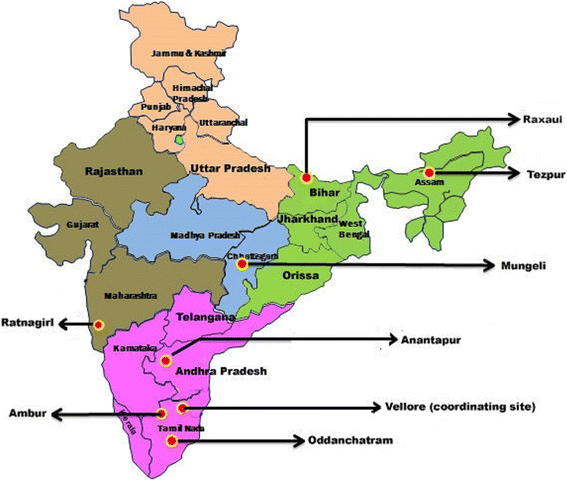Acute undifferentiated fever in India: a multicentre study of aetiology and diagnostic accuracy
- PMID: 28978319
- PMCID: PMC5628453
- DOI: 10.1186/s12879-017-2764-3
Acute undifferentiated fever in India: a multicentre study of aetiology and diagnostic accuracy
Abstract
Background: The objectives of this study were to determine the proportion of malaria, bacteraemia, scrub typhus, leptospirosis, chikungunya and dengue among hospitalized patients with acute undifferentiated fever in India, and to describe the performance of standard diagnostic methods.
Methods: During April 2011-November 2012, 1564 patients aged ≥5 years with febrile illness for 2-14 days were consecutively included in an observational study at seven community hospitals in six states in India. Malaria microscopy, blood culture, Dengue rapid NS1 antigen and IgM Combo test, Leptospira IgM ELISA, Scrub typhus IgM ELISA and Chikungunya IgM ELISA were routinely performed at the hospitals. Second line testing, Dengue IgM capture ELISA (MAC-ELISA), Scrub typhus immunofluorescence (IFA), Leptospira Microscopic Agglutination Test (MAT), malaria PCR and malaria immunochromatographic rapid diagnostic test (RDT) Parahit Total™ were performed at the coordinating centre. Convalescence samples were not available. Case definitions were as follows: Leptospirosis: Positive ELISA and positive MAT. Scrub typhus: Positive ELISA and positive IFA. Dengue: Positive RDT and/or positive MAC-ELISA. Chikungunya: Positive ELISA. Bacteraemia: Growth in blood culture excluding those defined as contaminants. Malaria: Positive genus-specific PCR.
Results: Malaria was diagnosed in 17% (268/1564) and among these 54% had P. falciparum. Dengue was diagnosed in 16% (244/1564). Bacteraemia was found in 8% (124/1564), and among these Salmonella typhi or S. paratyphi constituted 35%. Scrub typhus was diagnosed in 10%, leptospirosis in 7% and chikungunya in 6%. Fulfilling more than one case definition was common, most frequent in chikungunya where 26% (25/98) also had positive dengue test.
Conclusions: Malaria and dengue were the most common causes of fever in this study. A high overlap between case definitions probably reflects high prevalence of prior infections, cross reactivity and subclinical infections, rather than high prevalence of coinfections. Low accuracy of routine diagnostic tests should be taken into consideration when approaching the patient with acute undifferentiated fever in India.
Keywords: Bacteraemia; Chikungunya; Dengue; Diagnosis; India; Leptospirosis; Malaria; Prevalence; Scrub typhus.
Conflict of interest statement
Ethics approval and consent to participate
The study was approved by the Institutional Research Board at CMC, Vellore, Tamil Nadu (No. 7242 dated 11th of August 2010) and by the Regional Ethics Committee of Norway (2010/2271–5). Written informed consent was obtained from the patients.
Consent for publication
Not applicable
Competing interests
The authors declare that they have no competing interests.
Publisher’s Note
Springer Nature remains neutral with regard to jurisdictional claims in published maps and institutional affiliations.
Figures
References
-
- Kumar A, Valecha N, Jain T, Dash AP. Burden of malaria in India: retrospective and prospective view. The American journal of tropical medicine and hygiene. 2007;77(6 Suppl):69–78. - PubMed
-
- Dhingra N, Jha P, Sharma VP, Cohen AA, Jotkar RM, Rodriguez PS, Bassani DG, Suraweera W, Laxminarayan R, Peto R, et al. Adult and child malaria mortality in India: a nationally representative mortality survey. Lancet. 2010;376(9754):1768–1774. doi: 10.1016/S0140-6736(10)60831-8. - DOI - PMC - PubMed
-
- WHO: World malaria report 2014. 2014.
Publication types
MeSH terms
LinkOut - more resources
Full Text Sources
Other Literature Sources
Medical
Miscellaneous


